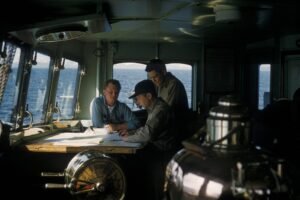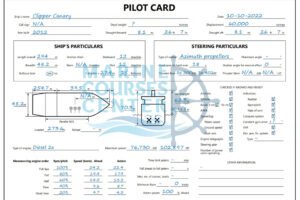
Admiralty List of Lights and Fog Signals (NP 74—NP82): The Ultimate Guide for Navigators

Admiralty List of Lights and Fog Signals (NP 74—NP82): The Ultimate Guide for Navigators
Admiralty List of Lights and Fog Signals (NP 74—NP82)
If you’re a sailor or involved in the maritime industry, then you’re likely familiar with the Admiralty List of Lights and Fog Signals. This series of publications, also known as NP 74-NP82, provides worldwide coverage and is divided into 11 volumes, A through L.
The purpose of the Admiralty List of Lights and Fog Signals is to give the latest known details of lights, light-structures, light-vessels, light-floats, lanbys, and fog signals. Light-buoys of a height of 8 meters or greater may also be listed, and some with a height of less than 8 meters are occasionally included in the list, as are light-buoys considered to be of primary navigational significance. Certain minor lights, in little frequented parts of the world covered only by small-scale charts, are included in the list though they are not charted.
The information provided in each publication is extensive and includes the international number, location name, geographical coordinates (latitude and longitude), characteristics of lights and fog signals, intensity, elevation in meters, range in sea miles, description of structure, equivalent foreign language light descriptions, a geographical range table for determining dipping distance, and a luminous range diagram for obtaining the range at which a light can be seen, allowing for its power and the prevailing visibility.
In this article, we’ll dive deeper into the Admiralty List of Lights and Fog Signals and explore how it benefits sailors and other maritime industry professionals.
I. Introduction
Introduction
Navigating the seas can be a perilous undertaking, especially when visibility is low. That’s why the Admiralty List of Lights and Fog Signals (NP 74—NP82) was created. This publication is a vital resource for mariners and provides information on lights, light-structures, light-vessels, light-floats, lighthouses, fog signals, and light-buoys. In this article, we will explore the purpose and importance of the Admiralty List of Lights and Fog Signals.
A. What is the Admiralty List of Lights and Fog Signals?
The Admiralty List of Lights and Fog Signals is a series of 11 volumes (A ~ L) that provides worldwide coverage of navigational lights and fog signals. The list contains the latest known details of lights and fog signals, including their location, characteristics, intensity, elevation, range, and structure. It also includes equivalent foreign language light descriptions, as well as a Geographical Range Table for determining Dipping Distance and a Luminous Range Diagram for obtaining the range at which a light can be seen.
B. Purpose of the Admiralty List of Lights and Fog Signals
The purpose of the Admiralty List of Lights and Fog Signals is to provide mariners with accurate and up-to-date information on navigational aids to help them navigate safely and efficiently. It is particularly useful in areas with low visibility, where fog signals and lights play a crucial role in ensuring safe navigation. The list also helps mariners to identify specific navigational aids quickly, using their international number, location name, and geographical coordinates.
Moreover, the Admiralty List of Lights and Fog Signals is essential for voyage planning, particularly when entering unfamiliar waters. It enables mariners to plan their routes effectively and ensure that they have the necessary equipment and knowledge to navigate safely. It is also useful for shipowners, insurers, and maritime authorities, as it provides comprehensive information on navigational aids, helping to prevent accidents and reduce risks.
In summary, the Admiralty List of Lights and Fog Signals is a critical resource for mariners, providing accurate and up-to-date information on navigational aids worldwide. Its purpose is to enhance safety and efficiency in navigation, particularly in low visibility conditions, and to support voyage planning and risk management.
II. Worldwide Coverage
A. 11 Volumes (A-L)
The Admiralty List of Lights and Fog Signals is an essential publication that provides information on lights and fog signals worldwide. The information is published in 11 volumes, labeled A through L, with each volume covering a different region of the world. This comprehensive coverage ensures that sailors and other navigators have access to the latest information on lights and fog signals, no matter where they are sailing.
B. Coverage of Lights and Fog Signals
The Admiralty List of Lights and Fog Signals provides information on various types of lights and fog signals used for navigation. These include lights on structures such as lighthouses, lightships, light buoys, and light vessels, as well as fog signals used to alert ships of nearby hazards or navigational aids. The list may also include light buoys less than 8 meters in height and some considered to be of primary navigational significance. The list is updated regularly to ensure accuracy and includes international numbers, location names, geographical coordinates, light characteristics and intensity, elevation, range, structure description, equivalent foreign language light descriptions, geographical range tables for determining dipping distance, and luminous range diagrams for obtaining the range at which a light can be seen.
III. Information Provided
A. International Number
The international number is a unique identifier assigned to each navigational aid around the world. This number is included in the Admiralty List of Lights and Fog Signals and is used to identify the aid in navigational charts and publications.
B. Location Name
The Admiralty List of Lights and Fog Signals includes the name of each location where a navigational aid is situated. This helps navigators to easily identify the aid when referring to the list.
C. Geographical Co-ordinates
Geographical co-ordinates, including latitude and longitude, are included for each navigational aid in the Admiralty List of Lights and Fog Signals. This information helps navigators to accurately locate and navigate to the aid.
D. Characteristics of Lights and Fog Signals
The characteristics of each light and fog signal are listed in the Admiralty List of Lights and Fog Signals. This includes the color, duration, and frequency of the light, as well as the type of fog signal and its characteristics.
E. Intensity
The intensity of each navigational aid is also included in the Admiralty List of Lights and Fog Signals. This information helps navigators to determine the distance at which the aid can be seen.
F. Elevation in Meters
The elevation of each navigational aid is listed in the Admiralty List of Lights and Fog Signals. This information is useful for navigators who need to determine the height of an aid when navigating in areas with varying depths.
G. Range in Sea Miles
The range of each navigational aid is included in the Admiralty List of Lights and Fog Signals. This information helps navigators to determine the distance at which the aid can be seen.
H. Description of Structure
A detailed description of each navigational aid’s structure is included in the Admiralty List of Lights and Fog Signals. This information helps navigators to easily identify the aid when navigating in poor visibility conditions.
I. Equivalent Foreign Language Light Descriptions
The Admiralty List of Lights and Fog Signals includes equivalent foreign language light descriptions for each navigational aid. This information is useful for international navigators who may not be familiar with the English language descriptions.
J. Geographical Range Table
A geographical range table is included in the Admiralty List of Lights and Fog Signals to help navigators determine the dipping distance of a light based on its height and the observer’s height above sea level.
K. Luminous Range Diagram
The Admiralty List of Lights and Fog Signals also includes a luminous range diagram for each navigational aid. This diagram helps navigators to determine the range at which a light can be seen, taking into account its power and the prevailing visibility conditions.
IV. Benefits of Admiralty List of Lights and Fog Signals
The Admiralty List of Lights and Fog Signals (NP 74—NP82) serves several important benefits for mariners and seafarers.
ِA One of the primary benefits is enhancing safety.
The information provided in the list allows mariners to be aware of the location, characteristics, and range of lights and fog signals, which helps them to avoid obstacles and navigate safely in poor visibility conditions.
Another benefit of the Admiralty List of Lights and Fog Signals is that it serves as a navigation aid.
By providing accurate and up-to-date information on the location, range, and intensity of lights and fog signals, seafarers can more easily navigate their vessels through the waterways. This is particularly important when entering and exiting ports, navigating through narrow channels, and passing through areas with a high density of maritime traffic.
Efficient planning is yet another benefit of the Admiralty List of Lights and Fog Signals. The list enables mariners to plan their voyages more effectively by providing them with essential information about lights and fog signals along their intended route. This enables them to select the best route, taking into consideration factors such as the range of the lights, their intensity, and their location. By doing so, they can avoid delays, save time, and ultimately, operate more efficiently.
In summary, the Admiralty List of Lights and Fog Signals is a crucial resource for seafarers, providing vital information on lights and fog signals worldwide. It serves several important benefits, including enhancing safety, serving as a navigation aid, and enabling efficient planning.
In conclusion
In conclusion, the Admiralty List of Lights and Fog Signals is an essential publication for mariners and seafarers. It provides comprehensive information about lights, light-structures, light-vessels, light-floats, lanbys, fog signals, and light-buoys that are of primary navigational significance. The information provided in the list helps in enhancing safety, aiding navigation, and efficient planning of sea voyages. With 11 volumes covering worldwide coverage, the Admiralty List of Lights and Fog Signals is an invaluable tool for safe navigation in the seas.
VI. FAQs
Here are some frequently asked questions about the Admiralty List of Lights and Fog Signals:
- What is the purpose of the Admiralty List of Lights and Fog Signals?
- The purpose of the Admiralty List of Lights and Fog Signals is to provide information about lights, light-structures, light-vessels, light-floats, lanbys, fog signals, and light-buoys that are of primary navigational significance.
- What information is provided in the Admiralty List of Lights and Fog Signals?
- The Admiralty List of Lights and Fog Signals provides information such as the international number, location name, geographical co-ordinates, characteristics of lights and fog signals, intensity, elevation in meters, range in sea miles, description of structure, equivalent foreign language light descriptions, geographical range table, and luminous range diagram.
- Who uses the Admiralty List of Lights and Fog Signals?
- The Admiralty List of Lights and Fog Signals is used by mariners and seafarers as a navigational aid to enhance safety and efficient planning of sea voyages.
- How many volumes does the Admiralty List of Lights and Fog Signals have?
- The Admiralty List of Lights and Fog Signals has 11 volumes covering worldwide coverage, from A to L.
- Are light-buoys with a height of less than 8 m included in the list?
- Yes, some light-buoys with a height of less than 8 m may be included in the list, as well as certain minor lights in little frequented parts of the world covered only by small scale charts, though they are not charted.














